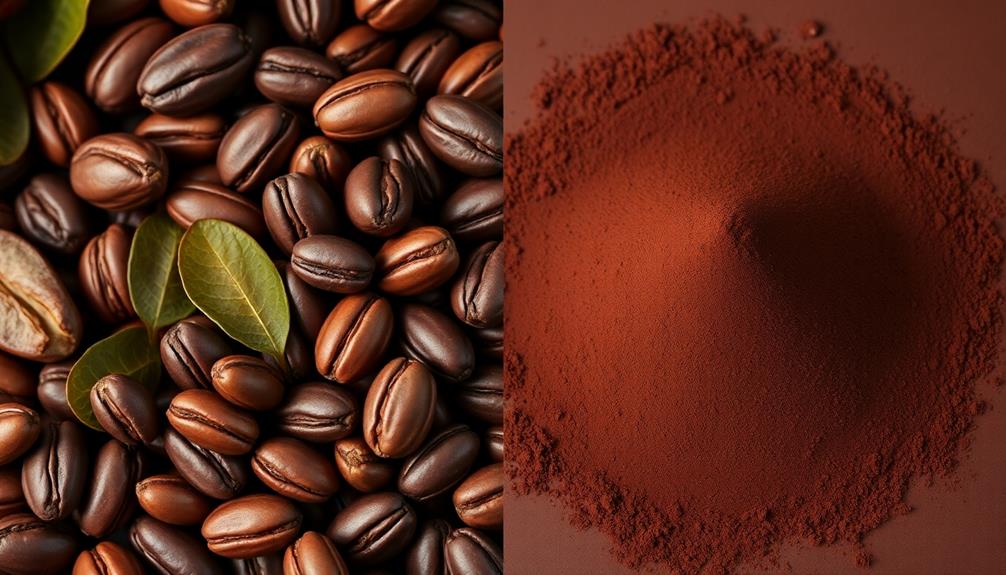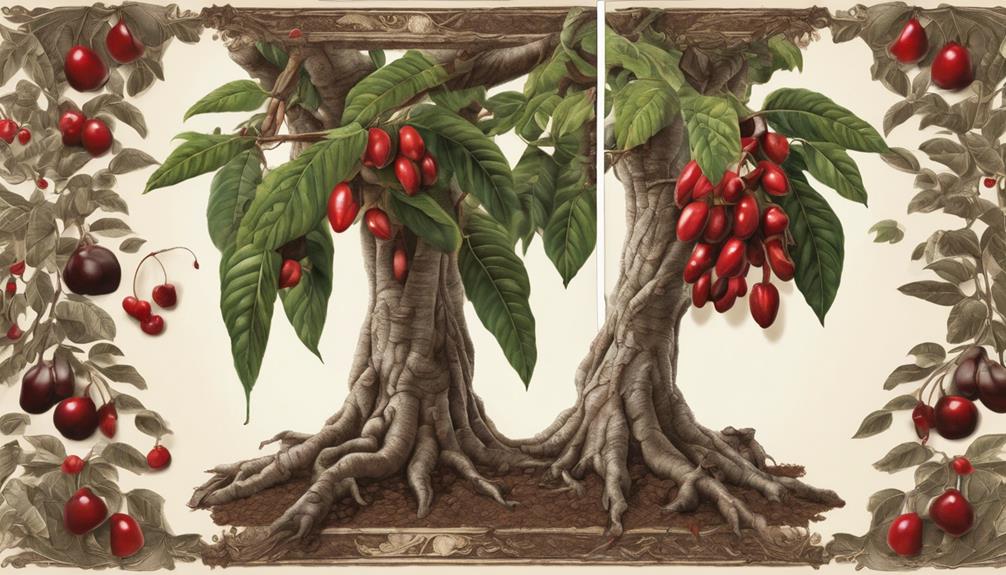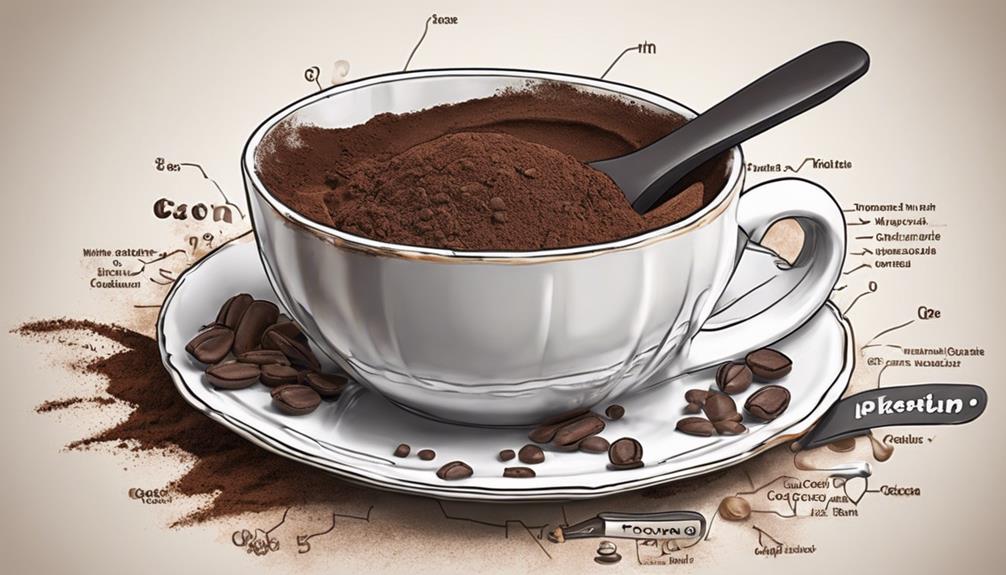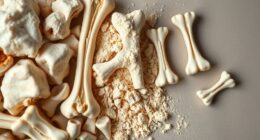When you compare raw cacao to Dutch-processed cocoa, you'll notice key differences in processing and flavor. Raw cacao is cold-pressed from unroasted beans, retaining more nutrients and offering a rich, intense chocolate flavor. On the other hand, Dutch-processed cocoa is treated to neutralize acidity, resulting in a smoother taste that's perfect for baking. Nutritionally, raw cacao shines with higher levels of antioxidants and essential minerals, while Dutch-processed cocoa has less nutrient content due to its processing. Your choice affects both the health benefits and the outcome of your recipes. Stick around to explore more about each type's culinary applications!
Key Takeaways
- Raw cacao is made from cold-pressed unroasted cocoa beans, preserving more nutrients, while Dutch-processed cocoa is treated to reduce acidity.
- Raw cacao retains higher antioxidant levels and essential nutrients, making it more nutrient-dense than Dutch-processed cocoa.
- Dutch-processed cocoa has a milder flavor and is preferred in baking for its rich color and smooth taste.
- Raw cacao is ideal for health-focused recipes like smoothies and energy bars, while Dutch cocoa suits desserts like cakes and brownies.
- Popular brands vary by processing method, with Navitas Organics for raw cacao and Guittard for Dutch-processed cocoa, impacting flavor and nutrition.
Processing Methods
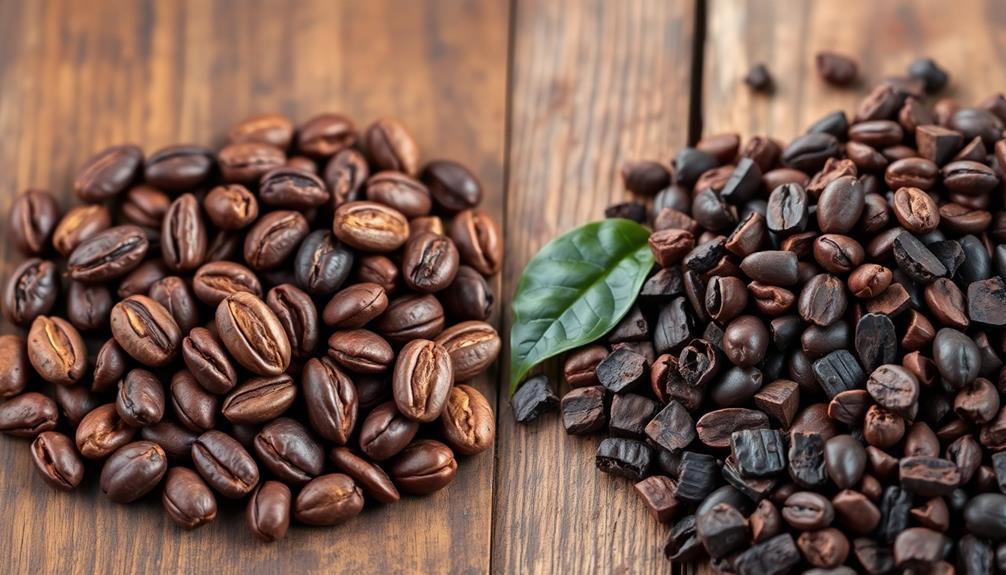
When it comes to processing methods, raw cacao and Dutch-processed cocoa represent two distinct approaches to transforming cocoa beans.
Raw cacao powder is made by cold-pressing unroasted cocoa beans, which helps preserve more nutrients and living enzymes. This method keeps the antioxidants intact, resulting in a rich, intense chocolate flavor that you can enjoy in various recipes.
On the other hand, Dutch-processed cocoa undergoes treatment with an alkalized solution, reducing its acidity and giving it a smoother, milder flavor.
These processing methods greatly impact the flavor, acidity, and overall health benefits of the cocoa products. While raw cacao retains more nutrients, Dutch-processed cocoa is often favored in baking for its rich, dark color and mellow taste, which can enhance the texture of your baked goods.
The choice between these two types of cocoa powder can influence your recipes, affecting everything from the final taste to the appearance of your treats.
Nutritional Benefits
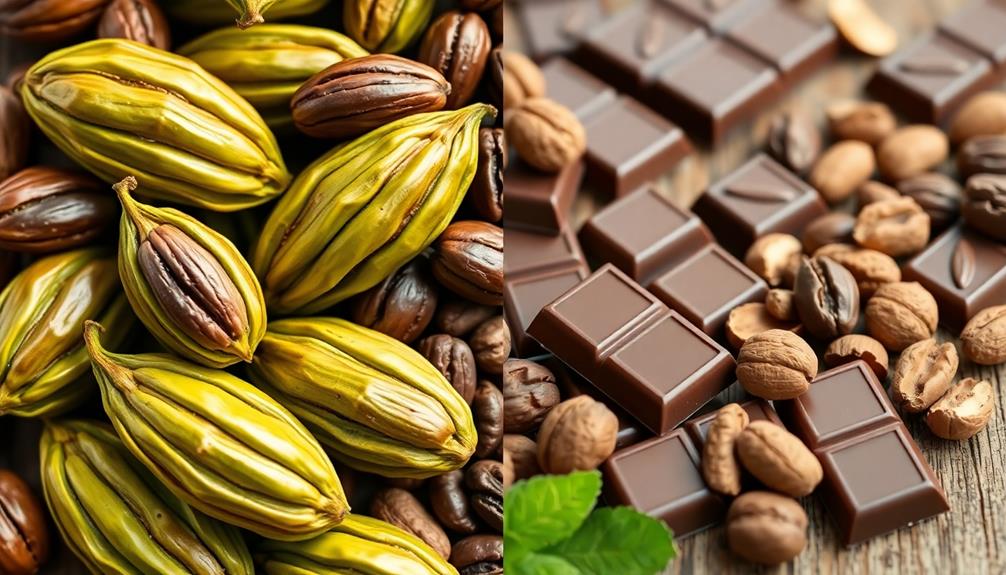
Raw cacao stands out as a nutritional powerhouse, packed with fiber, antioxidants, and essential nutrients. This superfood retains more vitamins and minerals than Dutch-processed cocoa due to its minimal processing. When you choose raw cacao, you're opting for a rich source of heart-healthy monounsaturated fats and cholesterol-free saturated fats that support cardiovascular health.
Additionally, the high antioxidant content in raw cacao can play a role in overall health, similar to the benefits of consuming cranberry juice for its antioxidant properties.
Notably, raw cacao boasts higher concentrations of magnesium, iron, and calcium, making it a more nutrient-dense option. These minerals are crucial for various bodily functions, including energy production, bone health, and muscle function.
While Dutch-processed cocoa still offers some antioxidants, the roasting process diminishes its nutrient content, rendering it less beneficial than raw cacao.
Both cacao and cocoa can help reduce stress and enhance mood, but the superior nutrient density in raw cacao may provide even more health advantages. Incorporating raw cacao into your diet can help you harness its impressive nutritional benefits, supporting your overall well-being.
Whether you enjoy it in smoothies, desserts, or snacks, raw cacao is a delicious way to boost your nutrient intake and enjoy its heart-healthy properties.
Culinary Applications
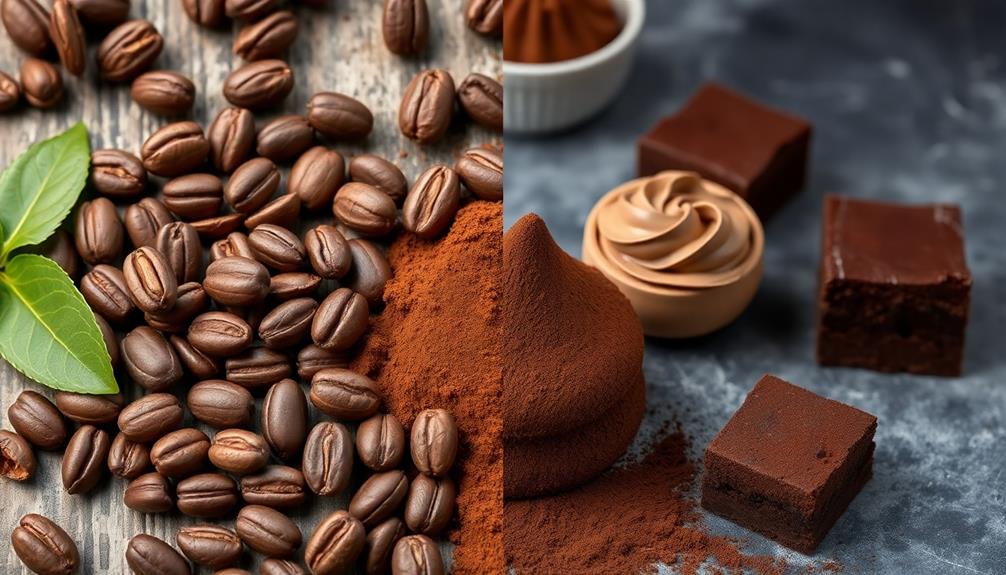
Culinary applications for raw cacao and Dutch-process cocoa highlight their unique flavors and uses in various recipes. If you're looking to enhance your cooking, understanding how each type can elevate your dishes is key. Here are some ways to incorporate them:
- Raw Cacao: Ideal for smoothies, protein bars, and granola, raw cacao provides an intense chocolate flavor with added nutritional benefits. It's perfect for health-conscious recipes that don't compromise on taste.
- Dutch-Process Cocoa: This cocoa powder shines in baking recipes like chocolate cake recipes and brownies. Its smoother taste profile complements desserts beautifully and enhances the overall flavor.
- Interchangeable Uses: Both raw cacao and Dutch-process cocoa can be used in sauces and frostings. However, keep in mind that when using Dutch-process cocoa, you'll need to adjust your chemical leaveners since it doesn't react with baking soda like natural cocoa powder does.
In the debate of cacao vs Dutch-process cocoa, knowing their culinary applications can help you choose the right ingredient for your next delicious creation!
Popular Brands
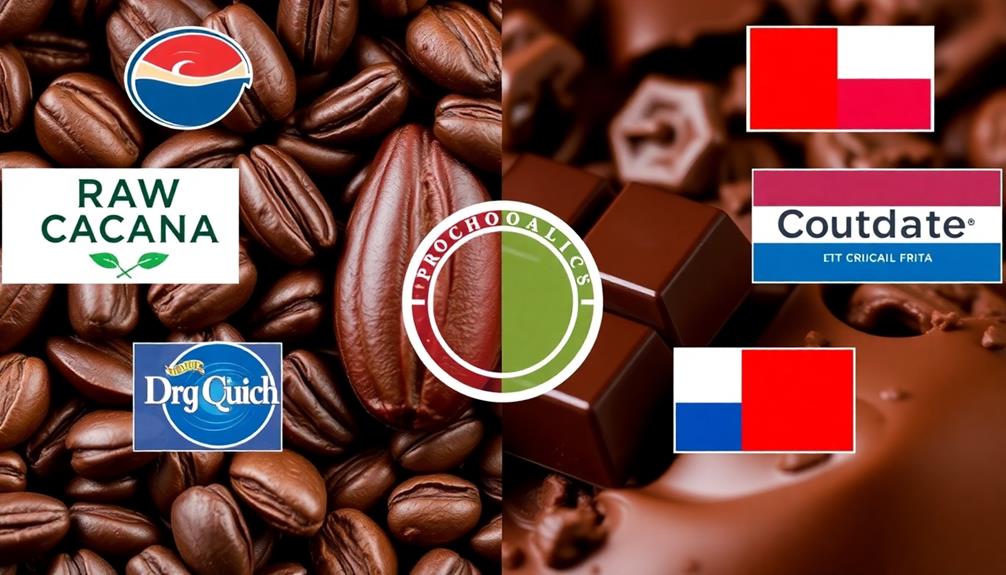
Understanding the differences in flavor and application between raw cacao and Dutch-process cocoa can guide your choices in the kitchen, but knowing which brands to trust is just as important.
For high-quality cacao powder, consider Navitas Organics and Healthworks. These brands offer nutrient-dense products made from unroasted cacao beans, ensuring you get the most out of the nutritional content.
When it comes to Dutch-processed cocoa, brands like Guittard and Scharffen Berger stand out for their rich flavors and reliable performance in baking.
If you're aiming for gourmet desserts, Valrhona cocoa is renowned among professional bakers for its deep color and complex flavor profile.
On the other hand, if you want a well-known option that appeals to home bakers, Hershey's Special Dark delivers a rich chocolate flavor with a darker hue.
Always check the processing method on the label, as it greatly impacts both flavor and nutritional content.
Recipe Ideas
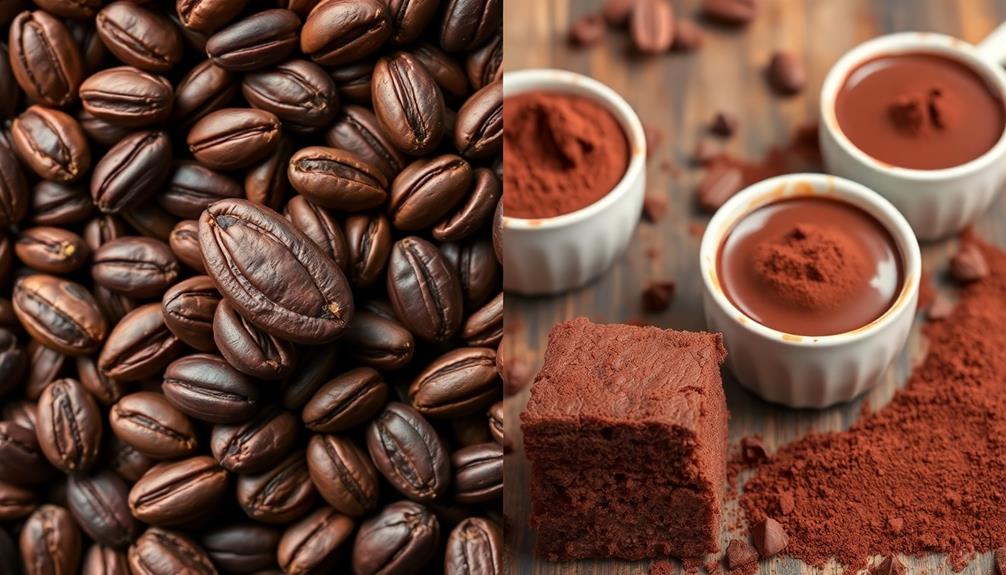
When exploring recipe ideas, you'll find that raw cacao and Dutch-processed cocoa each bring unique qualities to your creations.
Raw cacao powder provides a nutrient-dense chocolate flavor, perfect for health-conscious recipes, while Dutch-processed cocoa excels in baking rich desserts.
Here are three delicious recipe ideas to get you started:
- Chocolate Beetroot Cake: Use raw cacao powder for an intense chocolate flavor, along with the health benefits of beetroot. This cake is moist and packed with nutrients.
- Chocolate Gelato: Rely on Dutch-processed cocoa to create a creamy, dreamy chocolate gelato. Its smoother taste and deeper color will elevate this classic dessert.
- No-Bake Brownies: Combine raw cacao powder with nuts and dates for a quick, healthy treat. These no-bake brownies aren't only easy to make but also deliciously satisfying.
Feel free to experiment with both types of cocoa in your baking.
You can create decadent frostings with Dutch-processed cocoa or add raw cacao to granola for a healthier twist. The possibilities are endless!
Frequently Asked Questions
How Can You Tell if Cocoa Powder Is Dutch-Processed?
You can tell if cocoa powder is Dutch-processed by checking the label for terms like "Dutch" or "alkalized." It's usually darker in color and has a smoother, milder flavor compared to natural cocoa.
Is Dutch-Processed Cocoa Less Healthy?
You can't have your cake and eat it too. Dutch-processed cocoa is less healthy than raw cacao, as it undergoes alkalization, losing some antioxidants and nutrients. Moderation's key, depending on your dietary needs.
Can I Substitute Dutch Process Cocoa for Regular Cocoa?
You can substitute Dutch-process cocoa for regular cocoa, but it's essential to adjust leavening agents since it lacks acidity. This substitution may alter your recipe's flavor and texture, so be mindful of those changes.
What Is the Difference Between Alkali and Dutch Process Cocoa?
You're diving into a chocolate wonderland! Alkali cocoa undergoes an alkalization process, which smooths its acidity and flavor, while Dutch-process cocoa enhances that smoothness further, making it richer and deeper in taste for your baking adventures.
Conclusion
In the world of chocolate, raw cacao and Dutch process stand in stark contrast, each offering unique flavors and benefits. While raw cacao bursts with vibrant nutrients, Dutch process delivers a smooth, mellow richness. Choosing between them isn't just about taste; it's about embracing the raw energy of nature or the comforting familiarity of tradition. So, whether you crave the boldness of raw cacao or the velvety embrace of Dutch process, each bite tells a story worth savoring.

